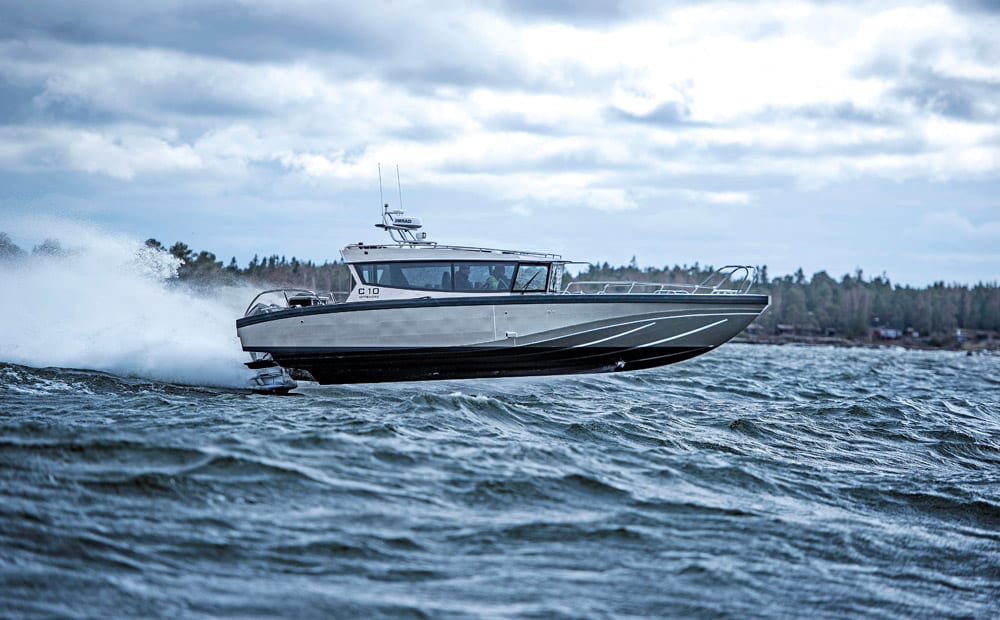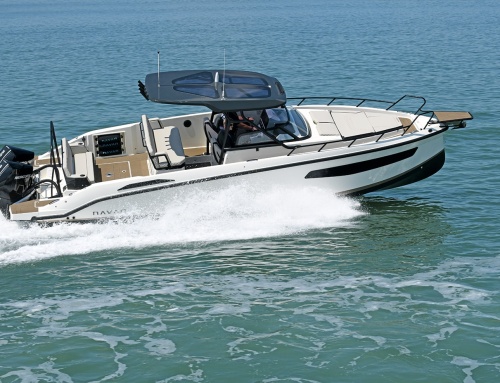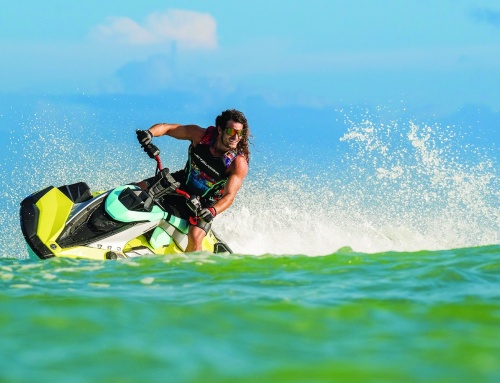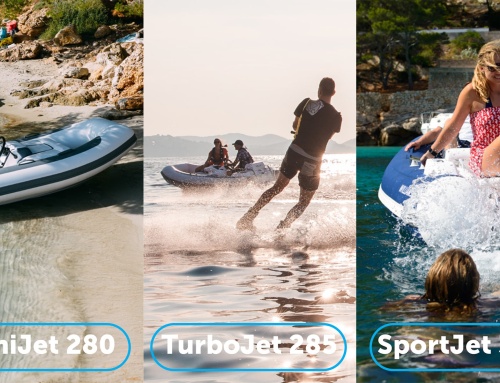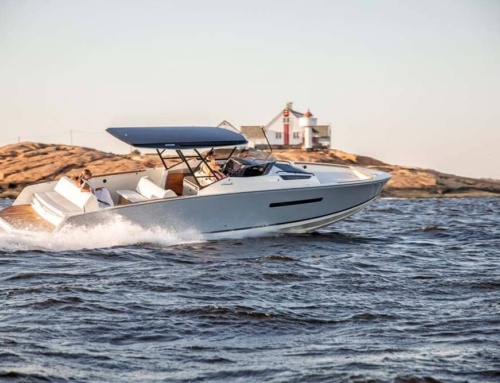Greg Copp tests Viggo C10 all-weather 60-knot express cruiser with a zero-compromise approach.
You may have chanced across this striking vessel if you visited SIBS this year. Its rakish lines and work boat-like aluminium construction may be slightly conflicting, but this boat has a clear purpose. Built for the Baltic, the Swedish C10 has been constructed to run through rough weather at speeds that few 33ft boats can match. VIGGO Boats have an ‘absolute approach’ to construction, focusing on what the serious offshore skipper really needs, rather than a broad concept tailored for the average pleasure boater.
Take a look at our walkaround at the Southampton Boat Show.
We tested the C10’s smaller sibling, the C8, two years earlier, thanks to its owner Simon Lunt, as VIGGO Boats have no UK dealers. It was his efforts that made this boat’s debut possible at Southampton. This small company, which builds just 25 to 30 boats a year – all by hand – has a purist approach to aluminium boatbuilding. Though keen to sell to the UK market, they have a different concept of marketing. If, like Simon, you are genuinely interested, they will fly you over, host you at a hotel and give you a tour of their construction facilities. You will then be given the opportunity to sample their produce in earnest. Construction time for the C10 is around a year, and once completed, VIGGO will arrange shipment.
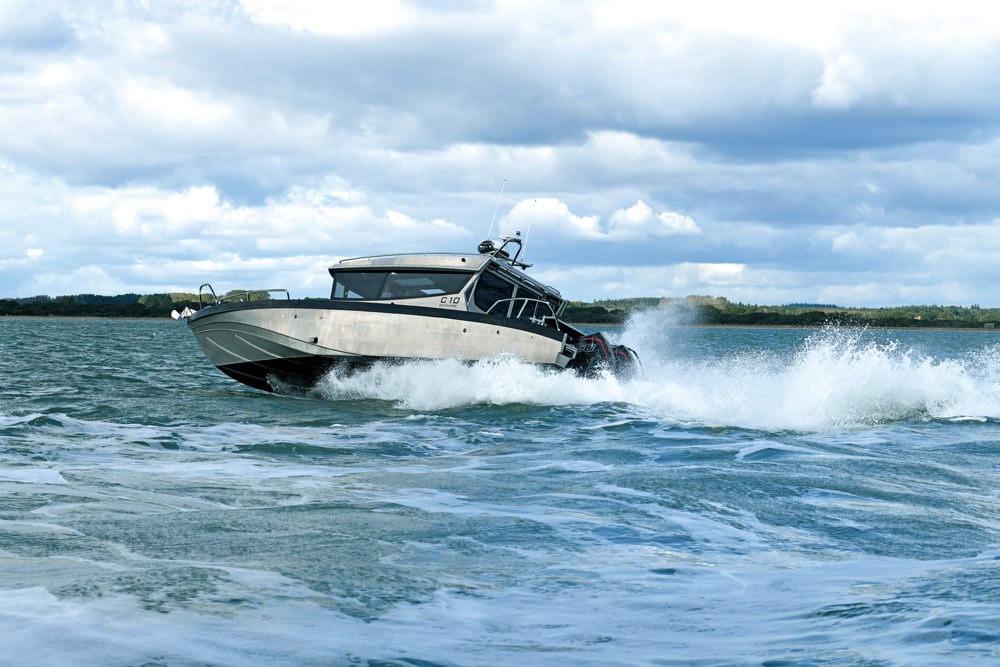
Hull construction is nothing short of impressive. The lattice-like network of longitudinal stringers and transverse frame supports, which lie under the deck, is something rarely seen in a pleasure boat – and much stronger for being made from aluminium. This level of overengineering is very reassuring, though to a Scandinavian who often needs to beach his boat on a shoreline of solid rock, it simply makes good sense. Access to the boat can either be into the cockpit by stepping over the bulwarks (while using the convenient roof handrail), via the bathing platforms or by stepping up onto the forward section in front of the windscreen. There are also steps leading up to the pulpit, enabling you to jump down onto the beach, or step up to a dockside. The beach-landing concept is very much Scandinavian, where island hopping around the archipelagos is commonplace.

A very serious dash layout.

Helm ergonomics are very good.

The X-Craft shock mitigation seat bases are built for abuse.
The cockpit has two flanking seats that sit on either beam, with a drop-in table between. You can opt for a transom bench seat, but our test boat was fitted with a tough framed panel that wrapped around and over the outboards. This has a purpose other than a leaning rest, as it serves to contain some of the spray that gets sucked up into the cockpit at speed. However, it does not work alone, as a discreet air scoop located on the aft edge of the coachroof provides an air blast towards the framed panel, the end result being that you do not need to wash down the back of the wheelhouse after a fast day out. The flanking seats not only provide storage beneath, but each one houses a large fuel stopcock. The concept is that you can run each engine either from the forward or the aft tank – consequently keeping fore and aft trim as even as possible. Alternatively, if you anticipate a day of running into big head seas, you can drain the aft tank first before switching to the forward one. The starboard bathing platform also serves to house the standard-fitment stern anchor, the windlass for which sits beneath the deck just forward of it. On the port platform, a bathing ladder hides within. Most of the cockpit floor comprises a large deck hatch, which opens to reveal a lined storage compartment that can be hinged forward to provide access right down to the keel and the substantial stringer/transverse frame support network.

The forward door is a feat of engineering.

Cabin space is very spacious.

A double bed that is really a triple.

Blackout curtains are part of this boat’s overnighting dimension.
The wheelhouse has a slightly softer character to its exterior, sporting soft internal linings, a ceiling-mounted TV, non-slip flooring in various forms – in the case of our test boat, a texturised grey – and various seating options. One option is to have three forward-facing shock-mitigating seats, and two single bench-type seats behind that convert to sideways-facing settees. Along with the aft settee, which can extend across the aft doorway, this provides extensive seating around the drop-in table. If you need to overnight, there is a folding aluminium section that transforms this whole area into a huge double bed. Designed to be used in the testing weather of the Baltic, there are two powerful diesel heaters blowing in from the front of the wheelhouse, and since wet crewmembers often create humidity and internal fogging, there is an extraction fan system running along the back of the wheelhouse.
The helm is truly a driver’s delight. The shock-mitigating bucket seat keeps you secure, with the throttles and wheel coming perfectly to hand. The electronics comprise two Simrad 16in MFDs, providing enough screen space for the radar, GPS, charts, sonar, rear camera and engine/trim data. Large primary switches and the bow and stern thruster controls sit on a horizontal dash section, all overlooked on the port side by a wireless phone-charging cradle. However, the most impressive aspects of the helm set-up are the paddle stick controls beneath the wheel. One central stick controls engine trim if you do not want to use the Mercury Active Trim system, and sticks in the four and eight o’clock positions activate the whopping Mercury Racing trim tabs. The paddle sticks work a treat, as you can rapidly tab the boat in real time, without having to dab at a switch panel while trying to look at a wave pattern. However, the most interesting feature that VIGGO have developed for driving this boat in head seas is their Central Trim system. This is a large central V-shaped trim tab that wraps around the keel at the transom and is driven by some serious hydraulic rams. Activated by a switch panel in front of the wheel, when fully deployed it puts an additional 200kg of pressure on the bow. Given that the bulletproof bow has a deadrise angle of 55 degrees, Central Trim can make light work of big waves.

Plenty of underdeck storage in the cockpit. 2: Paper chart storage – a feature often forgotten.
The twin navigator seats have the often forgotten luxury of a chart table, and forward of this the rarely forgotten luxury of a fridge. Opposite, on the starboard side of the forward wheelhouse door, sits a hatch giving access to the electrical systems, all of which are impeccably labelled and easily to hand. The battleship-like forward door hinges upwards, giving access to the dagger-like forward section of the boat. Small access doors on either side house the diesel heaters, while providing some extra storage to complement the lockers under the two bench seats. What you do not expect is that you can opt to have a heads under the forepeak steps. With the steps hinged upwards, a toilet tent emerges like a jack-in-the-box. Surprisingly, there is sufficient depth for a proper electric/manual toilet, coupled to a holding tank further aft.
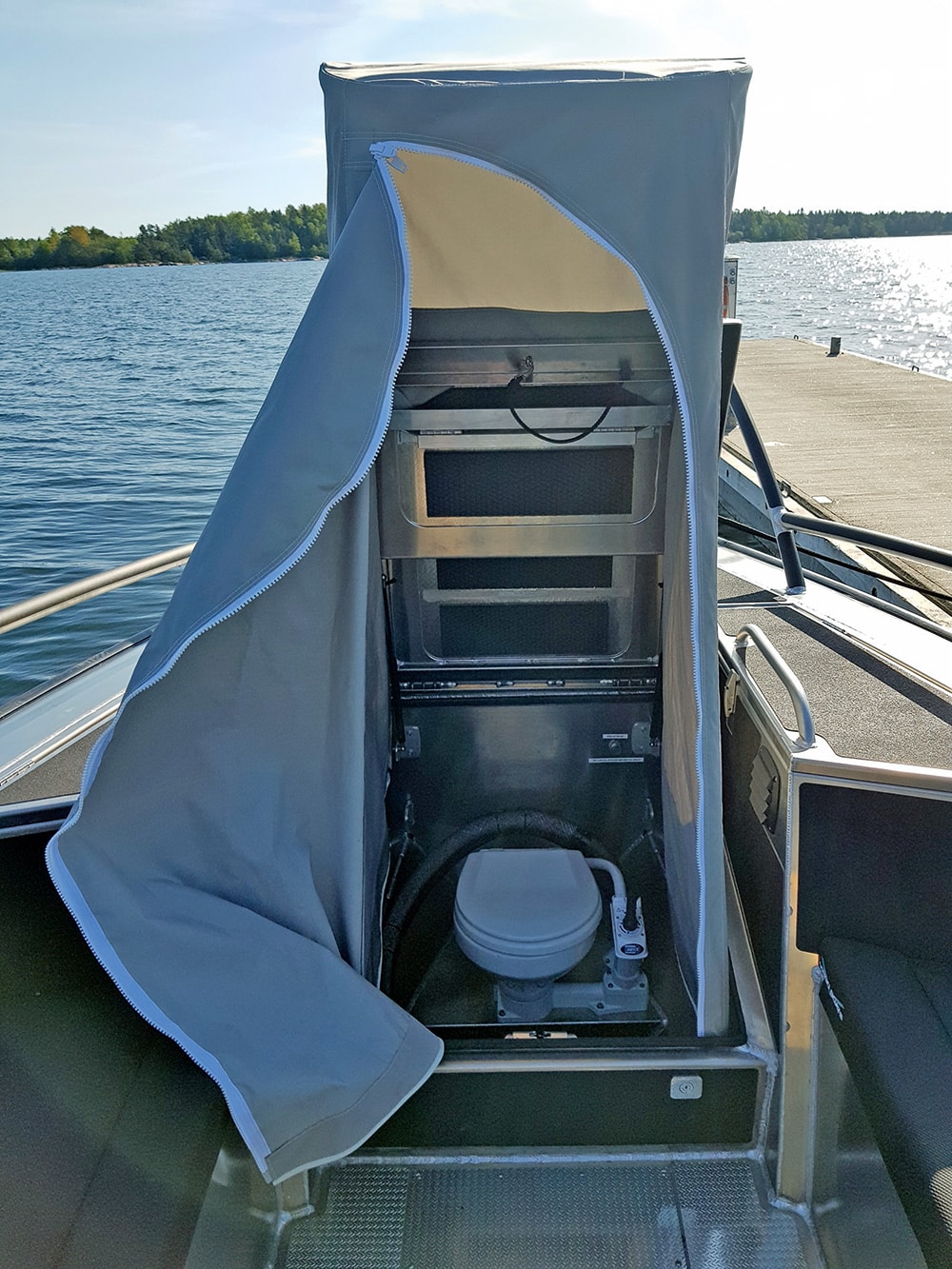
A jack-in-the-box heads sits in the forepeak.
Driving the C10
The moment you settle in behind the helm, you get the impression that this is a boat with which to clock up some fast sea miles. She picks up rapidly without a hint of cavitation, with a throaty roar from the twin supercharged V8s. With this vessel, life begins at 40 (knots), which she reaches in 10 seconds. However, the C10 does plane as low as 15 knots – which I doubt you will consider unless you are in the most demanding conditions. At 40 knots she is in her element, burning just a fraction more fuel than at 26 knots. This pace seemed surreal, as we were running into a south-westerly F6, which most 33-footers are capable of dealing with, but not in such a chilled manner as the C10. Its sharp 55-degree forefoot does a superb job of cutting through rough weather, and being aluminium, there is never a hint of complaint, although I was yet to experience the full head sea potential. Simon advised me to activate the Central Trim system to the full and push the twin Mercury 450Rs to wide open throttle. The bow drops a touch further, and a soft ride becomes softer. Due to good weight distribution, this boat has excellent poise without any assistance, but its trim tabs and Central Trim system put the icing on the cake – which the fuel figures reflect. I feel it is fair to say that running out into the increasing sea state in the western approach to the Solent at 58 knots, the C10’s reassuring composure was nothing short of impressive.

Paper chart storage – a feature often forgotten.
What I like about the paddle stick controls for the Mercury trim tabs is that you can use them instantly and accurately, making the concept of an auto trim system pretty redundant in this boat. If you are changing course quickly in relation to the wind, the ability to instantly trim the boat with a simple push of a stick is very handy. Tucking into hard turns is an easy point-and-shoot experience, especially given that the C10 only needs around 10–15% trim out on the outboards when running at full speed, so tucking them in for hard turns is instant. The hull hangs on doggedly, with the rubbing strake virtually dipping into the water, as she tracks round like an 8m sports boat. For the more laid-back approach, Mercury’s Active Trim system is ideal for calmer-water use, or when you just want to relax on passage.
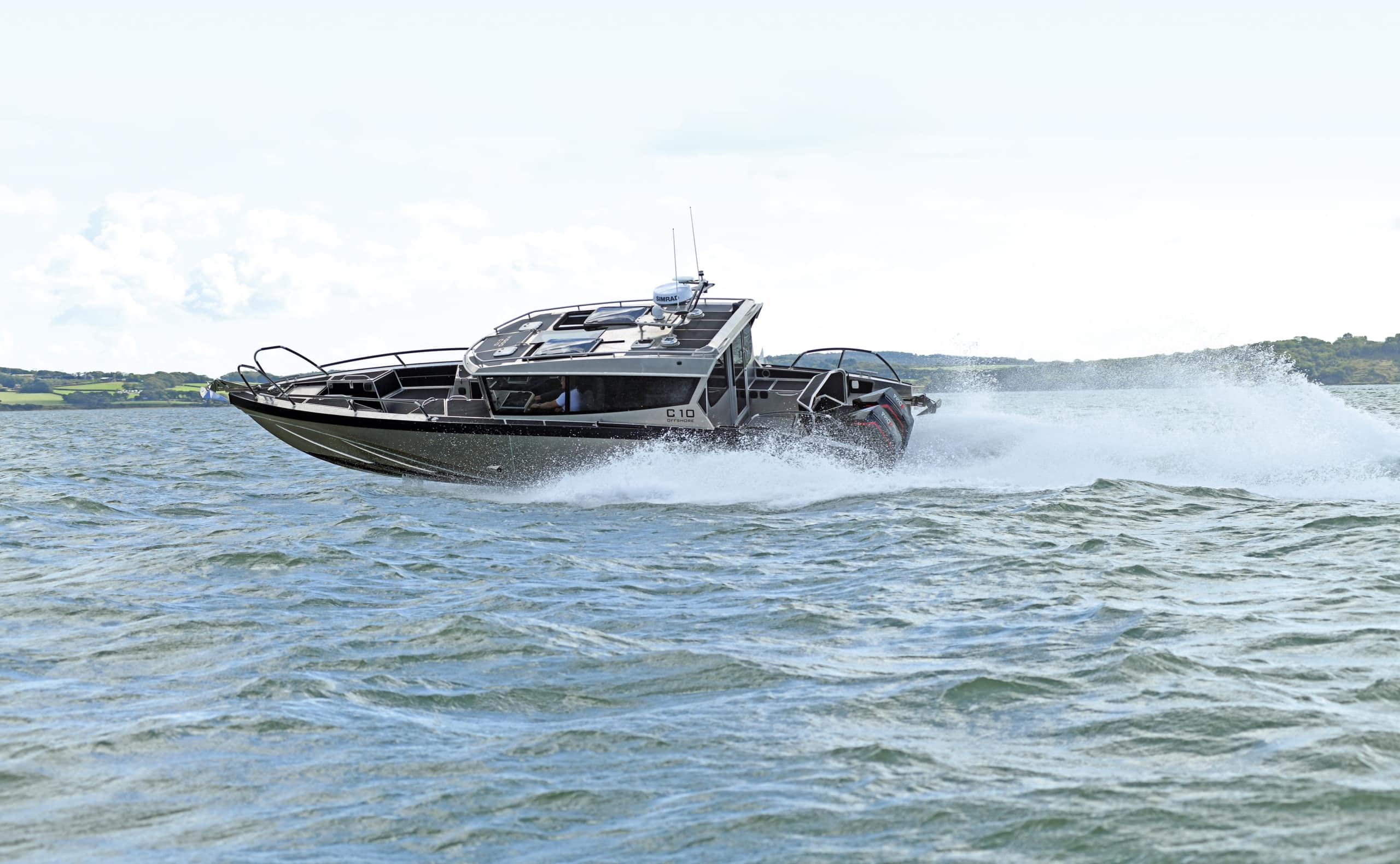
Verdict
This is a boat that is easy to drive fast in rough weather. Its tough aluminium construction makes it virtually abuse-proof, and having been designed to deal with a worst-case scenario in waters like the Baltic, everything is overengineered. There is even a specific app with a complete system guide, and VIGGO will not hand over the boat until you have been through their detailed induction course – including driving it. It does lack conventional creature comforts, but this is a Scandinavian boat built for people that actually use boats to commute in all weather conditions. Engine options range from twin 300hp V8 Mercury outboards to the new 500hp supercharged V8 Mercury in twin-rig form.
What we thought
For
- Great seakeeping and handling
- Rapid performance
- Great helm set-up
- Very solid build quality – virtually impossible to abuse
- Practicality/safety
- Fuel efficiency
- 200-mile range with a 20% reserve at 40 knots
Against
- No UK dealership as such
- For some it may appear too spartan with basic overnighting facilities

Specifications
- LOA: 10.95m
- Beam: 2.95m
- Draught (max.): 1m
- Transom deadrise angle: 24 degrees
- Bow deadrise angle: 55 degrees
- Displacement: 4500kg (dry with 450hp Mercury Verado 450Rs)
- Mercury power options: Twin 300hp V8s, twin 400hp V10s, twin 450hp V8s, twin 500hp Mercury V8s
- Fuel capacity: 885L in two tanks
- RCD category: B for 10
- Test engine: Twin 450hp Mercury Verado 450R V8s
Performance
- 58.2 knots (2-way average), sea conditions F6, with 70% fuel and three crew
Price (INC VAT)
- From: £480,000 with twin 300hp Mercury V8s
- As tested: £520,000 approx
Contact
- VIGGO Boats, Sweden
UK ambassador for VIGGO, Simon Lunt, at: simon.lunt@viggoboats.se

